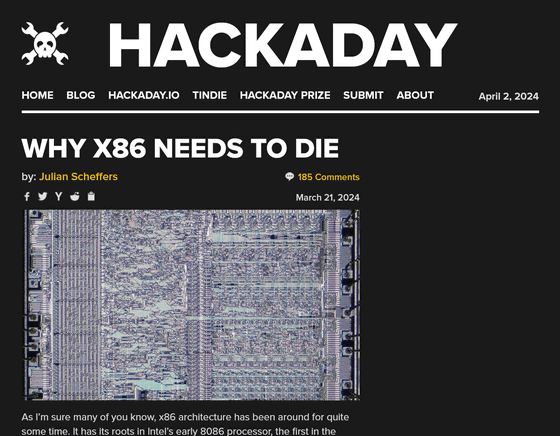Claims that the CPU instruction set architecture 'x86' will perish in the near future

Why X86 Needs To Die | Hackaday
https://hackaday.com/2024/03/21/why-x86-needs-to-die/

Modern CPUs that use x86 are part of the von Neumann architecture, characterized by CISC (complex instruction set computer ), ' superscalar ' (multiple instructions can be executed per clock cycle), ' out-of-order execution ' (reordering instructions to speed them up), and ' speculative execution' (executing instructions at branch destinations without knowing whether they will be satisfied). x86 was originally the instruction set for the Intel 8086, a 16-bit processor, but was expanded to accommodate 32-bit and then 64-bit processors.

After 46 years of expansion, the x86 instruction set has become very complex, requiring a lot of time and resources to fetch and decode instructions.
For example, the instruction 'mpsadbw' is 6-7 bytes long and compares a sequence of 4 bytes at multiple positions in an 11-byte sequence. Normally, instructions manipulate data in registers, but there is also a version of the instruction 'mpsadbw' that manipulates data in memory directly. This means that there are two variations of this instruction: a register manipulation version and a memory access version. However, the memory access version complicates the decoding of the instruction because the register manipulation version only requires you to specify the register number, whereas the memory access version requires you to specify how to calculate the memory address.
Modern x86 CPUs also support instructions like 'mpsadbw', but they are rarely used in real programs. Hackaday argues that x86 has many complex and infrequently used instructions, which is one of the reasons why the x86 architecture is less efficient.

In recent years, architectures such as Arm and RISC-V have also emerged. Arm is a RISC- based processor architecture developed by Arm Ltd. in the UK, characterized by low power consumption and high cost performance, and is mainly used in mobile devices such as smartphones and embedded systems. In recent years, the Arm architecture has also been adopted in Apple Silicon, which Apple incorporates into MacBooks and Macs, and in Amazon Web Services (AWS)'s instance processor 'Graviton.'
Amazon announces AWS processor 'Graviton4' and AI training chip 'Trainium2' - GIGAZINE

RISC-V is an instruction set architecture developed at the University of California, Berkeley. It features a simple and efficient design, and since it is royalty-free, anyone can freely use, modify, and redistribute it. RISC-V is also highly customizable, allowing you to select the functions you need and add your own extended instructions. Furthermore, because it is open source, its use in educational institutions is spreading, and it is expected to become an important architecture for the next generation of computer engineers.
RISC-V is used in microcontrollers and embedded systems, but it is gradually being adopted for high-performance platforms. For example, the European Processor Initiative (EPI), a project to develop next-generation supercomputers in Europe, has decided to adopt RISC-V-based processors.
Arm and RISC-V feature simpler and more efficient designs compared to x86, giving them strength in certain markets, but while these architectures continue to grow, x86 faces the burden of complexity and may lose market share in the future.

x86 is tied to the roots of a relatively old instruction set and has lost the benefits of small code size it had 46 years ago. The complexities of superscalar, speculative, and out-of-order execution are a heavy burden on an instruction set that is already very complex by definition. In addition, Arm and RISC-V are gradually gaining market share. Hackaday said, 'Don't get me wrong, I don't hate x86, and I'm not saying that x86 should die today. But one thing is clear: x86's days are numbered.'
In response to Hackaday's claims, Chips and Cheese, which handles hardware reviews and news, said, 'Hackaday's arguments have been irrelevant for decades. Modern CPUs use advanced techniques such as superscalar, out-of-order execution, and register renaming, regardless of the instruction set, and architectural design and implementation are far more important than the instruction set. Also, legacy support such as x86 real mode is essential to maintain software compatibility and avoid fragmentation, as in Arm-based smartphones.'
Why x86 Doesn't Need to Die – Chips and Cheese
https://chipsandcheese.com/2024/03/27/why-x86-doesnt-need-to-die/

◆ Forum is currently open
A forum related to this article has been set up on the official GIGAZINE Discord server . Anyone can post freely, so please feel free to comment! If you do not have a Discord account, please refer to the account creation procedure article to create an account!
• Discord | 'Which CPU architecture do you think will dominate in the next few decades: x86, Arm, or RISC-V?' | GIGAZINE
https://discord.com/channels/1037961069903216680/1226834793577185350
Related Posts:
in Hardware, Posted by log1i_yk







